This post may contain affiliate links, please view our disclosure policy for more details.
Shellfish might not be the first thing that comes to mind when it comes to the first foods to introduce to your baby. In fact, it might even be one of those foods that you’re feeling a bit nervous about introducing.
Maybe you’re concerned about shellfish being an allergen or nervous about how to cook it. Or maybe you’re just confused about how to serve your baby food that comes in a hard shell.
We get it! Shellfish is by no means the most straightforward food to prepare. But there are some really good reasons why you shouldn’t hold off on introducing shellfish to your baby.
Our goal is to put your mind at ease, and answer all of your burning questions so that you feel ready to roll up your sleeves, shuck those shells, and introduce shellfish to your baby safely and confidently!
If you want to learn more about how and what to feed your baby, you’ll love our Baby Led Feeding Course + 60 Day Baby Led Feeding Meal Plan bundle! Our course guides you through how to serve food to prevent picky eating and explains everything you need to know about introducing top allergens like shellfish!
Plus, our meal plan takes the stress out of deciding what to serve, complete with strategic allergen introductions, grocery lists, and video instructions!
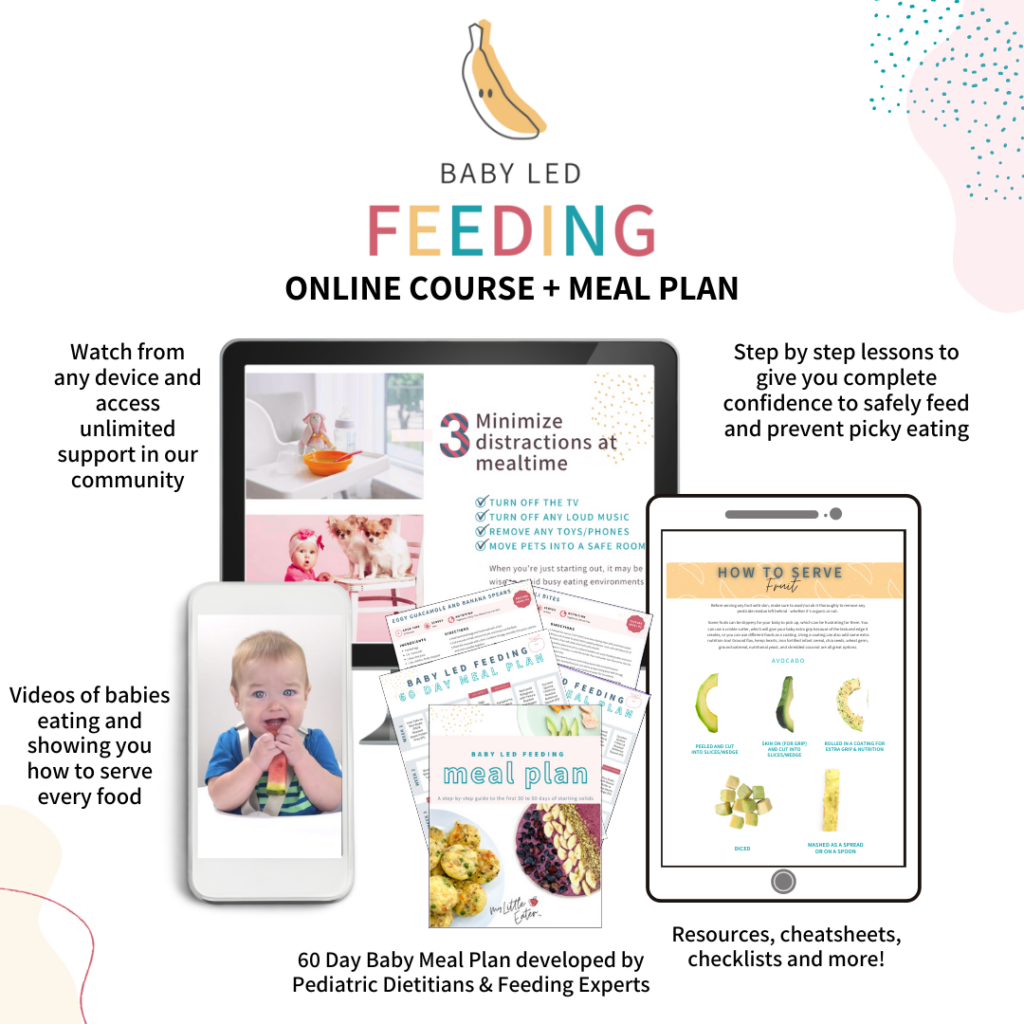
If you want to learn more about how and what to feed your baby, you’ll love our Baby Led Feeding Course + 60 Day Baby Led Feeding Meal Plan bundle! Our course guides you through how to serve food to prevent picky eating and explains everything you need to know about introducing top allergens like shellfish!
Plus, our meal plan takes the stress out of deciding what to serve, complete with strategic allergen introductions, grocery lists, and video instructions!

Table of Contents
What is shellfish?
Before we dive in, let’s ensure that we’re all on the same page…what is shellfish? And how is it different from regular fish?
Shellfish falls under the umbrella term “seafood”. However, unlike its finned fish relatives, shellfish are characterized by having a hard outer shell and no backbone. Shellfish can be further categorized into two groups – crustaceans and mollusks (1).
Common crustaceans include (1):
- Lobster
- Crab
- Crayfish
- Shrimp
- Krill
- Prawn


Common crustaceans include (1):
- Lobster
- Crab
- Crayfish
- Shrimp
- Krill
- Prawn

Common mollusks include (1):
- Clams
- Scallops
- Oysters
- Mussels
- Sea snails
- Squid
- Octopus
When can babies eat shellfish?
Babies can eat shellfish right away when they start solids at around 6 months, provided they’re showing all the developmental signs of readiness.
We encourage you to introduce shellfish early on in your baby’s feeding journey, aiming for as close to 6 months as possible for allergy prevention purposes.

How to prepare shellfish for babies
Here are some examples of how to safely prepare shellfish for your baby according to different levels of texture difficulty using the Texture Timeline™.
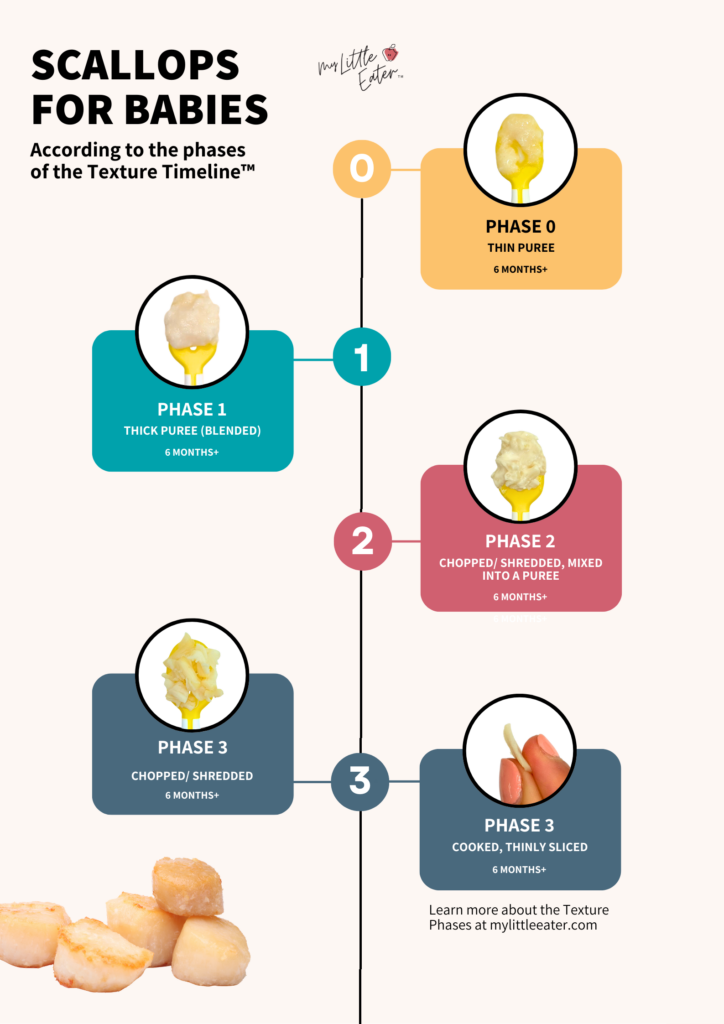
Scallops
Shrimp
There are a lot of different types of shellfish out there, and many different ways to prepare each type. No matter how you choose to prepare shellfish, there are a few things to keep in mind when it comes to safely preparing it for your baby.
Remove the hard outer shell
This one may sound like a no-brainer, but make sure that you remove the hard outer shell from shellfish before serving it to your baby. These shells can be sharp, not to mention make it more difficult for babies to get to the yummy edible part inside.
Once your little one is a bit older, you can teach them how fun it is to shuck shellfish and turn it into a food play activity. But for now, it’s best to take the time to remove the shell for them.

Use the "squish test"
An easy way to make sure that a piece of shellfish is soft enough for your baby to eat safely is by doing what we like to call, “the squish test”. All you need to do is squish a piece of shellfish between your thumb and index finger using gentle pressure.
If it squishes down easily, that means that your baby will easily be able to mash that food down with the pressure of their gums so that they can chew and eat it safely.

Modify the texture as needed
Shellfish can easily be modified to minimize choking risk and to be made less challenging in texture. Some ways to modify the texture and shape of shellfish include: blending, chopping, mixing it into a purée, or thinly slicing it.
Shellfish can also be slippery – you can roll pieces of shellfish into a delicious coating like nutritional yeast to give it more grip while also adding an extra boost of nutrition!
If you want to start by puréeing shellfish instead of going right to finger foods, that’s completely fine too! You can gradually work your way up to those more challenging, rubbery textures at your and your baby’s own pace using our Texture Timeline™.

Modify the shape to minimize choking risk
Shellfish tend to be firm and slippery in texture, which means that small, perfectly rounded pieces can be hard to manipulate in the mouth and can end up blocking your baby’s airway.
When serving shellfish to your baby as a finger food, it’s important to modify it appropriately to minimize this risk. There are a couple of different ways to prepare shellfish safely – you can thinly slice shellfish, roughly chop it, or cook it into a recipe.
Chopped
Roughly chop cooked shellfish (like cooked shrimp, crab, or lobster) into small pieces about ½-1 inch in size. When chopping shellfish, take advantage of the flakey texture and leave jagged edges. This will help to make sure that the pieces aren’t completely round, making them easier for your baby to manipulate in their mouth.

Thinly sliced
Thinly slice shellfish (like cooked scallops, mussels, clams, or oysters) so that each piece is about 1mm in thickness. You should almost be able to see through each slice!
This will eliminate the rounded shape of the shellfish to reduce risk of choking, and also make it easier for your baby to break down between their gums.

Cooked into a recipe
Cooking with shellfish is an easy way to transform it into an easier texture. For example, shrimp on its own is rubbery and slippery in texture, but cooking it into shrimp cakes makes it into a soft, pancake-like texture.
You can find our recipe for shrimp cakes below and in our 60-Day Baby Led Feeding Meal Plan.

Flavor with spices and herbs
It’s not recommended to add salt to your baby’s food, however that doesn’t mean that they have to eat bland meals! Adding spices and herbs is an easy way to broaden your baby’s palate and introduce them to new flavors.
You can add flavor to shellfish by adding seasonings like lemon juice and dried dill, zaatar spice, paprika, cumin, garlic powder, or onion powder!
Is shellfish an allergen?
Yes. Shellfish is one of the priority allergens recognized in Canada and the United States (U.S.) (1,2). Shellfish allergy affects around 2% of the population worldwide (3).
Fun Facts!
Fun Facts!
Shellfish allergies usually develop later in life and are more common in adults than in babies or young children (3). Despite this, it’s still recommended to introduce shellfish to your baby soon after starting solids and continue offering it regularly from there, like any other allergen (4).
Like shellfish, finned fish is also a priority allergen in Canada and the U.S. However, an allergy to finned fish does not automatically mean an allergy to shellfish, or vice versa (1).
An allergy to one type of shellfish doesn’t even guarantee an allergy to every kind of shellfish. It’s possible to be allergic to both crustaceans and mollusks, but this is not always the case (1,5). Interestingly enough, Canada includes both mollusks and crustaceans as top allergens, while the U.S. only lists crustaceans (2,3).

Do you have to introduce crustaceans & mollusks separately?
Current recommendations don’t specify the need to introduce mollusks and crustaceans as separate allergens. This is why we only focus on the introduction of one type of shellfish in our meal plan. We consider that sufficient to rule out shellfish as an allergy.
However, if you’d like to be extra cautious, you can introduce crustaceans and mollusks as top allergens separately. Regardless of what you choose to do, if your baby has an allergic reaction to one type of shellfish, it’s important that you contact an allergist for your next steps.
Do not reintroduce the type of shellfish they reacted to – or any other type of shellfish – prior to speaking to an allergist.
FPIES allergic reactions to shellfish
Aside from being a top allergenic food, it’s also possible for shellfish to cause a reaction called food protein-induced enterocolitis syndrome (FPIES) (6). FPIES is a type of food allergy that causes a sensitivity to the protein in certain foods (7).
Unlike with “typical” food allergies where allergic symptoms tend to show up very quickly, symptoms of FPIES are more delayed and can appear up to 3 hours after eating (8,9).

Symptoms of FPIES include (8,9):
- Excessive vomiting
- Excessive diarrhoea
- Lethargy
- Dehydration
Thankfully, most children grow out of FPIES by around age five (7). However, discussing proper reintroduction protocols for the food with your child’s allergist is important for deciding when to test it again and how to do so safely.
Allergen introduction protocols for shellfish
We get it – introducing allergenic foods to your baby can feel really scary and overwhelming. But knowledge is power!
Knowing how to introduce an allergen and getting familiar with the signs of an allergic reaction before it happens can help you go into the experience more confidently.

Here are a few key points to keep in mind when introducing shellfish for the first time.
Introduce one allergenic food at a time
Top allergens like shellfish can be introduced for the first time along with other foods, however, it’s important to only introduce one top allergen at a time. Otherwise, it would be hard to tell which allergen your baby is reacting to.
Introduce shellfish when your baby is healthy
Only introduce top allergens like shellfish when your baby is healthy. If they have a cold or a flu, it can be easy to mistake symptoms of an allergic reaction for pre-existing cold and flu symptoms.
Introduce allergenic foods early in the day
Most allergic reactions occur within minutes but can appear up to 2 hours after eating the food (10). It’s important to be around to closely monitor your baby during this time for any signs of an allergic reaction.
This is why we suggest an introduction early in the day. We wouldn’t want your baby trying the food for the first time at dinner and then going to bed shortly after.
Know the signs of an allergic reaction
Some common signs of an allergic reaction to look out for include (1):
- Widespread skin hives
- Swelling of the face, lips, or tongue
- Coughing/wheezing/shortness of breath
- Watery eyes
- Nasal congestion
- Changes in skin color (ie. pale or blue)
If your baby has any of the above reactions after introducing shellfish, stop serving the food and contact their pediatrician for your next steps. Or, if the reaction is severe (involves multiple different symptoms and/or is affecting your baby’s ability to breathe), call 911 and request an ambulance right away.

Continue offering shellfish frequently
Once you’ve ruled out shellfish as an allergy, it’s important to keep it on the menu regularly. Repeated exposure to top allergenic foods can help your baby maintain a tolerance to them, and reduce the risk that an allergy will develop later on (11).
Aim to offer shellfish once per week, or at least a few times per month to reduce your baby’s chances of developing an allergy (12,13).
Watch ingredient labels for hidden shellfish
Traces of shellfish can make their way into some sneaky places and appear in foods that you wouldn’t expect. Some sauces like fish sauce, oyster sauce, or salad dressings contain shellfish, and should therefore be considered a small exposure. It’s also important to remember to avoid these sneaky sources of shellfish if a shellfish allergy has been identified.
For more detailed information on how to introduce allergens to your baby and a day-by-day allergen introduction schedule, check out our Baby Led Feeding Course + 60 Day Baby Led Feeding Meal Plan bundle.
Is shellfish a choking hazard for babies?
Shellfish is not considered a common choking hazard for babies under 12 months of age (16). However, shellfish can be firm, rubbery, and slippery in texture which can make it challenging for new eaters.
Don’t let that scare you too much! The good news is that you can easily reduce your baby’s risk of choking on shellfish just by knowing how to safely prepare it.
In our signature tool called the Texture Timeline™, rubbery foods like shellfish fit into the most challenging category – phase 3. But this doesn’t mean that it can’t be safely offered from day one. Even phase 3 foods are safe for babies from the very beginning of starting solids and we show you exactly how to prepare them.
Learn more about the Texture Timeline™ and phase 3.

Is shellfish healthy for babies?
Aside from it being important to introduce your baby to shellfish for allergy prevention reasons, shellfish is an excellent source of nutrients that your baby needs to grow and thrive. Let’s talk about some of our key players – protein, omega-3, and iron!
Protein
To start, shellfish is an excellent source of protein. Most types of shellfish are even higher in protein than finned fish (17)!
The protein in shellfish is what’s called a “complete protein”, which means that it contains all of the essential amino acids that our bodies need to function properly, but cannot make on their own (18).

Omega-3 fatty acids
Shellfish is an excellent source of healthy polyunsaturated fats called omega-3 fatty acids – particularly eicosapentaenoic acid (EPA) and docosahexaenoic acid (DHA) (17,18,19). EPA and DHA are needed to support healthy brain development (20,21), so your baby needs to get enough of it from a young age.
The adequate intake amount is 0.5g per day between 6-12 months (22). While all shellfish contain some omega-3, mussels and oysters are an especially good source containing 0.66g and 0.53g, respectively per 3oz serving – that’s over 100% of the recommended adequate intake (22, 23, 24)!
Iron
Shellfish is also a good source of one of the most important nutrients for babies—iron (25)! Babies need iron from food sources starting at 6 months to help their brains grow and develop normally (26). Iron also helps with the production of red blood cells, which are needed to carry oxygen from the lungs to the rest of the body (26).
Read more about the importance of iron for babies.

Shellfish is an excellent source of other key vitamins and minerals like vitamins A, D, E, B12, zinc, choline…and the list goes on (18,19,21,25)!
The takeaway? While shellfish may not be the first food that comes to mind to feed your baby, it’s a highly nutritious option that can and should be included in your baby’s diet.
How to prevent foodborne illness
Some mollusk shellfish like oysters, clams, scallops, and mussels are “bivalves” which means that they have a top and a bottom shell. This type of shellfish in particular has an increased risk of causing foodborne illness because of toxins, viruses, and bacteria like Vibrio that can get trapped between their shells (14).
Because babies have underdeveloped immune systems and can’t fight off infection the same way that healthy grown adults can, it’s even more important to protect them from foodborne illness (14). To do this, there are a few things to keep in mind when it comes to choosing, storing, and preparing shellfish to make sure that you’re serving it to your baby as safely as possible.
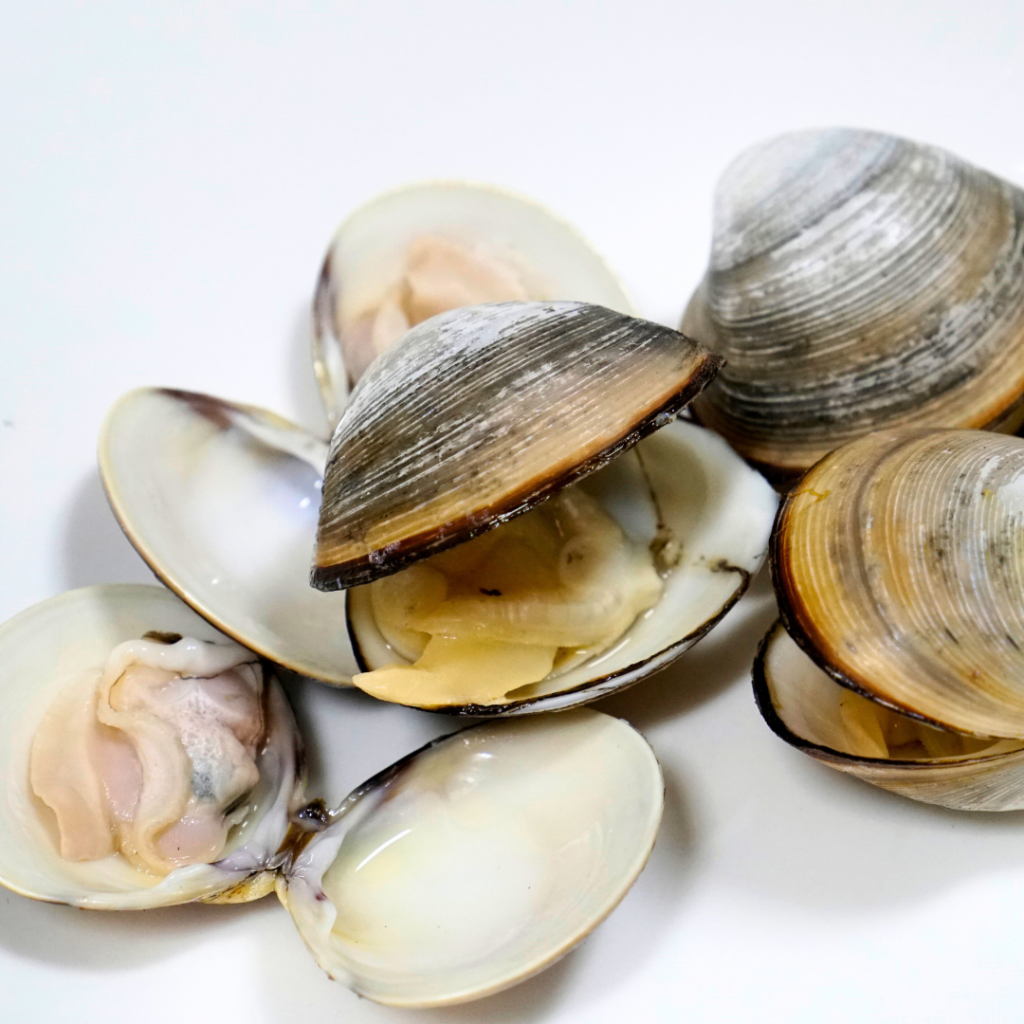
Buying shellfish
When buying fresh, live shellfish in store, make sure that the top and bottom shells are tightly closed, or close when lightly tapped. This indicates that the shellfish are alive and safe to cook and eat (14).
Shellfish can also be bought frozen. Frozen shellfish are typically frozen raw when the shellfish are alive and fresh, so they’re safe to cook and eat as long as they’ve been stored properly, and thawed safely.
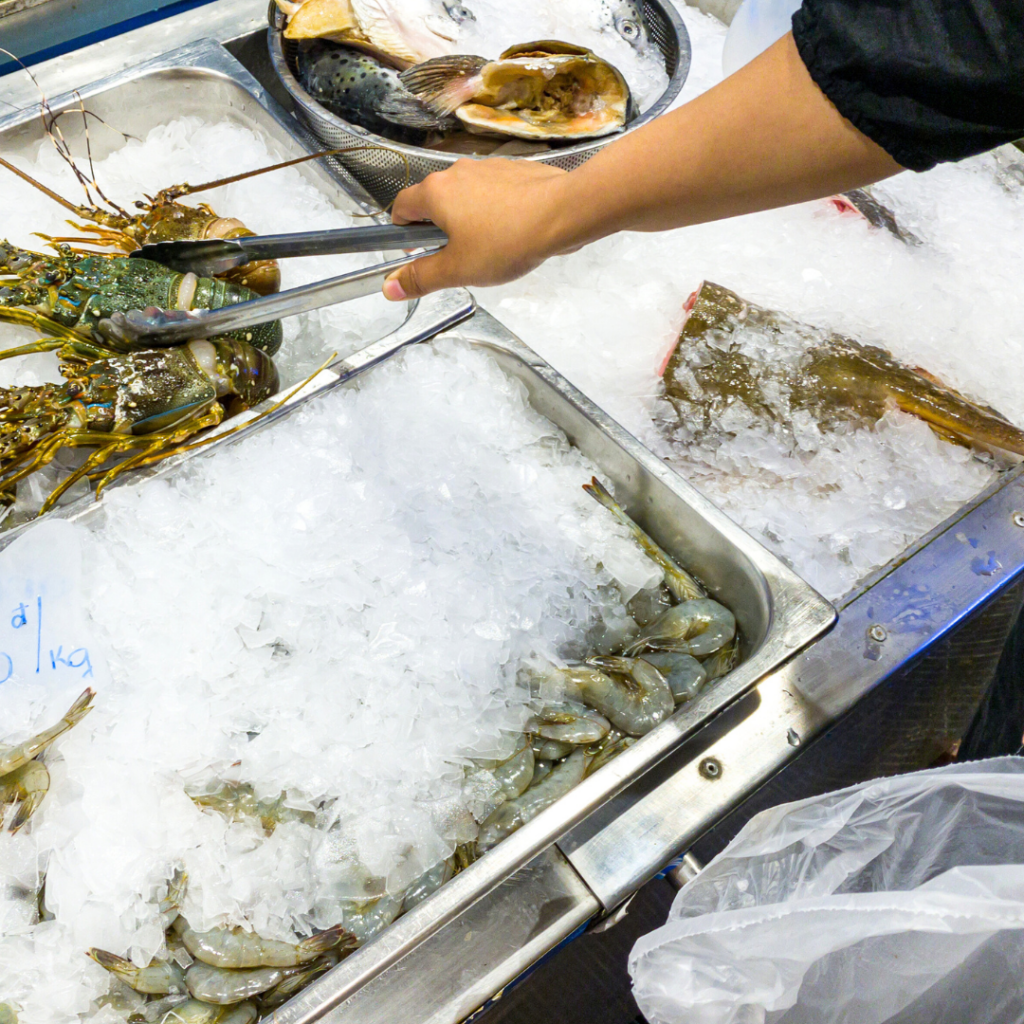
Storing shellfish before cooking
Raw, live shellfish should be stored in the refrigerator (below 4°C/40°F). Store the shellfish in an open container with a damp cloth covering the shells. Or, if shellfish has been opened (shucked), store it in a closed container. Raw, fresh shellfish can be stored in the refrigerator before cooking for a maximum of 2 days (14).
Frozen shellfish should be transferred to your freezer right away after being brought home from the store. It should also remain frozen until you’re ready to cook it. Raw shellfish can be safely stored in the freezer for a maximum of 4 months (14).
Thawing frozen shellfish before cooking
While you can cook shellfish directly from frozen, thawing it before cooking can help to speed up the cooking process and make sure that it cooks more evenly.
The safest ways to thaw frozen shellfish before cooking are to either thaw it in the refrigerator or to thaw underneath cold running water in the sink. Shellfish should be cooked as soon as possible after being thawed (14).
You should never thaw shellfish at room temperature – this puts it at increased risk for bacterial growth!
Cooking shellfish
As a first step before cooking shellfish, we encourage you to thoroughly scrub the shells with a stiff bristle brush under running water. This can help to further reduce the risk of contamination. Once you’ve done this, you can get cooking!

Shellfish needs to be thoroughly cooked to make sure that any bacteria, toxins, and viruses are killed off before being served to your baby. You can do this by boiling, frying, steaming, or baking them until an internal temperature of 74°C/165°F has been reached.
While it may seem tempting to cook shellfish for an extra long time to make sure that it’s safe for your baby, overcooking shellfish can make it more rubbery in texture than it already is. This can make it more challenging for your baby to eat – especially while they’re still learning how to master new textures.
Stick to internal cook temperature guidelines for the most accurate way of cooking shellfish safely.
It’s also important that shellfish like clams, oysters, scallops, and mussels be cooked until their shell opens. Any shells that do not open should not be served to your baby. In fact, it’s recommended that adults refrain from eating shellfish that have not opened up after being cooked as well (15).
How often can my baby eat shellfish?
In general, your baby can safely eat shellfish about twice per week. The reason why there’s a limit is because shellfish, like all seafood, contains some mercury (27).
Mercury is a heavy metal that naturally exists in the environment, but bacteria in marine environments cause mercury to transform into methylmercury which is a known neurotoxin (27,28). Fish and shellfish that live in the ocean are therefore exposed to methylmercury, and it accumulates in their tissue (27).
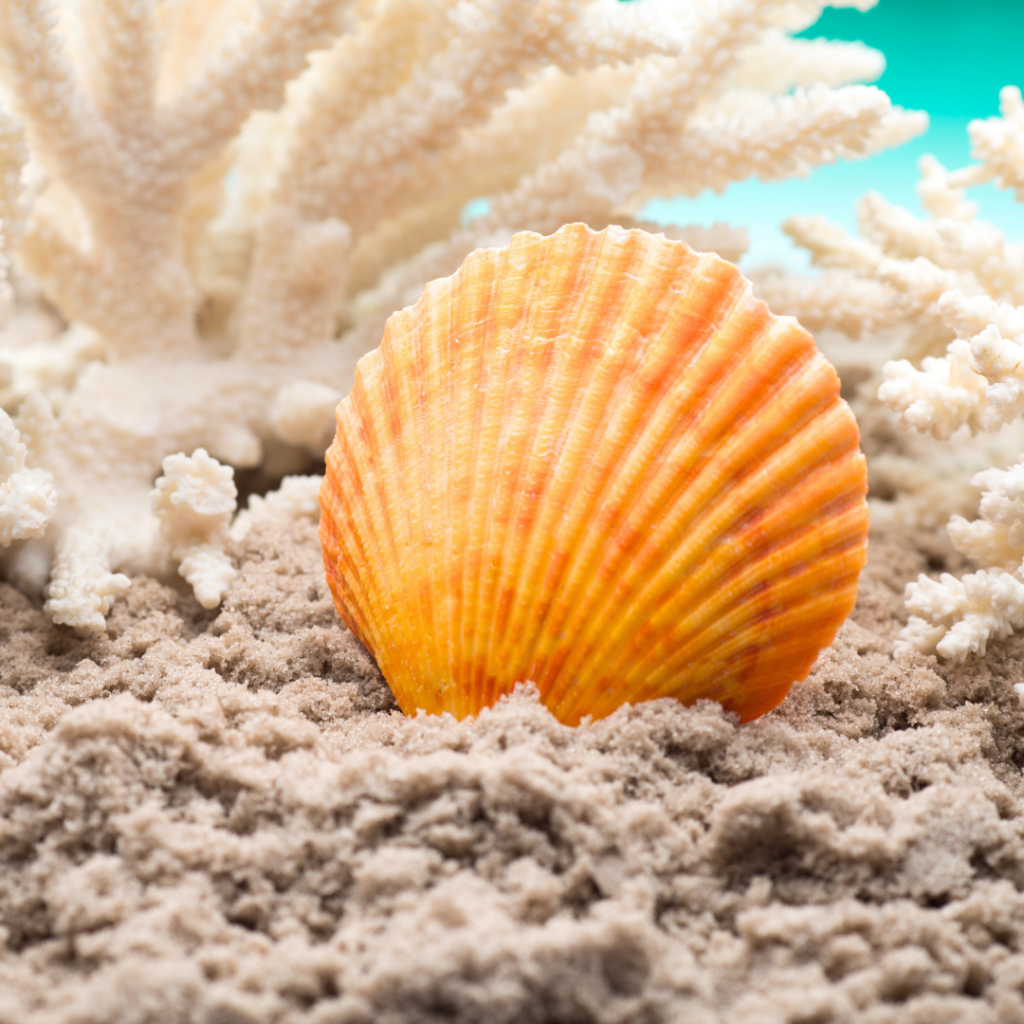
When we eat seafood, we then become exposed to methylmercury too. Children and babies are especially vulnerable to the effects of methylmercury, as it can be harmful to brain development (27). Thankfully, certain types of seafood are lower in mercury than others.
Generally, the larger the fish and the higher it is on the food chain (meaning it eats lots of mercury-containing fish), the higher its methylmercury content (29).
Since shellfish are small and low on the food chain, they generally fall within what we call the ultra-low mercury category (measured as 0.06ppm methylmercury or less). They are therefore safe choices to consume more regularly (up to twice per week) (30).
The exception to this is lobster, which is considered to be moderately high in mercury, depending on where it’s sourced from (29,30). It’s still ok to offer lobster to your baby once in a while, however, we recommend limiting your baby’s exposure to no more than once per month.
Recommended next...
Read more about how we categorize ultra-low mercury seafood in our “best fish for babies” blog.
We hope this helped you feel ready and confident to introduce shellfish to your baby! If you’re looking for a recipe to get started with, try out our recipe for shrimp cakes below from our 60-Day Baby Led Feeding Meal Plan. They’re quick, easy, flavorful, and can be enjoyed by babies and adults alike!
Shellfish FAQs
How can I introduce shellfish to my baby if I’m allergic?
If you’re allergic to shellfish, you might be wondering how you’re going to introduce it to your baby in a way that’s safe for both of you.
Thankfully, most people with a food allergy only develop a reaction when they eat the food and it’s unlikely to cause a severe reaction from just being around it (10). It is possible for highly sensitive people to have a reaction through skin contact, although this type of exposure is unlikely to result in a severe reaction (10).
That being said, if you do have an allergy, we don’t blame you for wanting to minimize your exposure to shellfish. Here are some options for extra precautions that you can take when introducing it to your baby:
- Wash your hands thoroughly with soap and hot water after touching shellfish. Or, to be extra cautious, you can wear rubber gloves while preparing and serving shellfish to your baby.
- Sanitize all kitchen surfaces, cutting boards, and dishware that have come in contact with shellfish using soap and hot water.
- Wash your baby’s hands and face after the meal using a warm cloth to remove any shellfish residue.
- Put your baby’s clothes in the washing machine if they come in contact with shellfish during the meal.
- Lay a garbage bag on the floor underneath your baby’s high chair. This will eliminate the need for you to touch shellfish pieces that have fallen on the ground while cleaning up.
Alternatively, if you’d like to be on the extra safe side, you can have a trusted loved one introduce shellfish to your baby. Just make sure that they’re well informed about the signs of an allergic reaction, and know what to do if a reaction were to occur.
Note: If you, the direct relative of your child, have an existing allergy to shellfish or any other food, your baby may be at an increased risk for developing a food allergy themselves (31). Speak to your baby’s pediatrician or allergist, as they may suggest that you introduce allergens earlier (between 4-6 months of age) to help reduce your baby’s risk of developing an allergy (31).
Does Benadryl help with shellfish allergy?
No, it’s not safe to give Benadryl to your baby under 2 years of age (32,33).
Benadryl is an over-the-counter allergy relief medication that falls under the category of an antihistamine – more specifically, Benadryl is a diphenhydramine.
Babies can’t process diphenhydramines the same way that adults can. Giving a diphenhydramine medication like Benadryl to a baby under two can result in dangerous, potentially life-threatening side effects like increased heart rate and convulsions (33).
Remember that if your baby is having an allergic reaction, it’s important to discontinue serving shellfish immediately and contact your pediatrician or allergist for next steps. Or, if the reaction is severe (involves multiple different symptoms and/or is affecting your baby’s ability to breathe), call 911 and request an ambulance right away.
Are there any types of shellfish that cannot be served at 6 months?
All types of shellfish can be modified to be safely served to babies. Texture modifications vary by each type of shellfish, but general methods include puréeing, thinly slicing, chopping, or cooking it into a recipe.
One exception is octopus, which is naturally very high in sodium at 391mg per 3oz serving (34). For this reason, we recommend waiting to serve octopus until your little one is at least 12 months old.
Shellfish can be very expensive, are canned options ok?
Canned shellfish tend to have added salt to help with preservation. If serving canned shellfish to your baby, look for one that is canned in water and has low to no added salt.
If you don’t have access to canned shellfish without added salt, you can thoroughly rinse the shellfish in a colander under cold water to remove excess sodium before preparing it for your baby.
Can I buy pre-packaged crab meat or lobster meat so I don’t have to remove it from the shell?
Yes! We completely understand wanting to save some time by buying pre-packaged shellfish instead of fresh. Pre-packaged crab and lobster meat are safe to offer to your baby. Just be sure that you’re purchasing real crab or lobster meat and not imitation.
Imitation crab and lobster meat are made from a mixture of white fish like pollock and small amounts of shellfish to mimic the taste and texture of real crab or lobster. Imitation products contain filler ingredients like starches, sugars, and flavorings.
While they do usually contain shellfish, it makes up less than 2% of the ingredients. This is not enough to properly introduce your baby to shellfish as an allergen.
If you choose to buy pre-packaged crab or lobster meat, look for one that has crab or lobster as the only ingredient.
If I make a shellfish puree, what should I mix it with?
You don’t have to purée shellfish on its own – make it into a balanced meal by adding a starchy carbohydrate, a vegetable or fruit, and spices!
Here are a few ideas for inspiration:
- Scallop, sweet potato, and broccoli purée with pepper
- Lobster, cauliflower, and lemon purée with dill
- Shrimp, rice, and green pea purée with garlic
- Crab, potato, and carrot purée with turmeric

Shrimp cakes
Equipment
- 1 large bowl
- 1 pan
- 1 large pot
- 1 Steamer basket
Ingredients
- 1 lb. raw shrimp (shelled and deveined)
- 1 cup panko bread crumbs
- 2 large eggs (beaten)
- 2 tbsp green onions (finely chopped)
- ½ lemon (juiced and zested)
- 2 tbsp mayonnaise
- ½ tsp paprika
- ½ tsp onion powder
- ½ tsp black pepper
- ¼ cup olive oil
- ½ cup cooked broccoli
Instructions
- Start by defrosting the shrimp in a bowl of warm (not hot) water for 10 minutes.
- Remove the shells and devein the shrimp. To devein it, grasp the shrimp on both sides of its body and gently squeeze. Make a shallow cut down the length of the shrimp's back, then lift out the vein with the tip of a knife. Alternatively, you can buy pre-shelled and deveined shrimp.
- Gently pulse the shrimp in a food processor until coarsely chopped, but not pureed. Alternatively, you can finely chop them with a knife.
- In a large bowl, combine the shrimp with the panko bread crumbs, eggs, green onions, lemon juice & zest, mayo, paprika, onion powder, and black pepper. Mix well.
- Divide the mixture into 8 portions and form each into a patty.
- Heat the olive oil in a shallow pan, over medium-high heat. Cook the shrimp patties for approximately 4 minutes on each side or until they are cooked through. You will likely have to do this in batches. If the shrimp cakes are browning too quickly on the outside, lower the temperature to ensure they cook through evenly.
- For the broccoli, fill a large pot halfway with water and bring it to a boil.
- Wash the broccoli and cut into florets (leave a good amount of stem on each floret).
- Place the broccoli in a steamer basket on top of the pot of water. Cover and steam for 10-15 minutes, or until fork tender.
Notes
If you want to learn more about how and what to feed your baby, you’ll love our Baby Led Feeding Program + 60 Day Baby Led Feeding Meal Plan bundle!
Our course guides you through how to serve food to prevent picky eating and explains everything you need to know about introducing top allergens like shellfish! Plus, our meal plan takes the stress out of deciding what to serve, complete with strategic allergen introductions, grocery lists, and video instructions!

References
- Government of Canada. (2017). Crustaceans and Molluscs – Priority food allergens. https://www.canada.ca/en/health-canada/services/food-nutrition/reports-publications/food-safety/seafood-fish-crustaceans-shellfish-priority-food-allergens.html
- U.S. Food & Drug Administration. (2024). Food Allergies. https://www.fda.gov/food/food-labeling-nutrition/food-allergies
- Lopata, A. L., Kleine-Tebbe, J., & Kamath, S. D. (2016). Allergens and molecular diagnostics of shellfish allergy: Part 22 of the Series Molecular Allergology. Allergo journal international, 25(7), 210–218. https://doi.org/10.1007/s40629-016-0124-2
- Kakieu Djossi, S., Khedr, A., Neupane, B., Proskuriakova, E., Jada, K., & Mostafa, J. A. (2022). Food Allergy Prevention: Early Versus Late Introduction of Food Allergens in Children. Cureus, 14(1), e21046. https://doi.org/10.7759/cureus.21046
- Warren, C. M., Aktas, O. N., Gupta, R. S., & Davis, C. M. (2019). Prevalence and characteristics of adult shellfish allergy in the United States. Journal of Allergy and Clinical Immunology, 144(5), 1435-1438.
- Nowak-Węgrzyn, A., Jarocka-Cyrta, E., & Moschione Castro, A. (2017). Food Protein-Induced Enterocolitis Syndrome. Journal of investigational allergology & clinical immunology, 27(1), 1–18. https://doi.org/10.18176/jiaci.0135
- Caubet, J.C., Ford, L.S., Sickles, L., Järvinen, K.M., Sicherer, S.H., Sampson, H.A., & Nowak-Węgrzyn, A. (2014). Clinical features and resolution of food protein–induced enterocolitis syndrome: 10-year experience, Journal of Allergy and Clinical Immunology, 134(2), 382-389.e4. https://doi.org/10.1016/j.jaci.2014.04.008
- Anvari, S., Miller, J., Yeh, C. Y., & Davis, C. M. (2019). IgE-Mediated Food Allergy. Clinical reviews in allergy & immunology, 57(2), 244–260. https://doi.org/10.1007/s12016-018-8710-3
- Feuille, E., & Nowak-Węgrzyn, A. (2015). Food Protein-Induced Enterocolitis Syndrome, Allergic Proctocolitis, and Enteropathy. Current allergy and asthma reports, 15(8), 50. https://doi.org/10.1007/s11882-015-0546-9
- American College of Allergy, Asthma & Immunology. (2023). Food Allergy. https://acaai.org/allergies/allergic-conditions/food/
- Abrams, E. M., Orkin, J., Cummings, C., Blair, B., & Chan, E. S. (2021). Dietary exposures and allergy prevention in high-risk infants. Paediatrics & child health, 26(8), 504–505. https://doi.org/10.1093/pch/pxab064
- Fleischer, D. M., Chan, E. S., Venter, C., Spergel, J. M., Abrams, E. M., Stukus, D., Groetch, M., Shaker, M., & Greenhawt, M. (2021). A Consensus Approach to the Primary Prevention of Food Allergy Through Nutrition: Guidance from the American Academy of Allergy, Asthma, and Immunology; American College of Allergy, Asthma, and Immunology; and the Canadian Society for Allergy and Clinical Immunology. The journal of allergy and clinical immunology. In practice, 9(1), 22–43.e4. https://doi.org/10.1016/j.jaip.2020.11.002
- Abrams, E. M., Ben-Shoshan, M., Protudjer, J. L. P., Lavine, E., & Chan, E. S. (2023). Early introduction is not enough: CSACI statement on the importance of ongoing regular ingestion as a means of food allergy prevention. Allergy, asthma, and clinical immunology : official journal of the Canadian Society of Allergy and Clinical Immunology, 19(1), 63. https://doi.org/10.1186/s13223-023-00814-2
- Government of Canada. (2011). Shellfish food safety. https://www.canada.ca/en/health-canada/services/meat-poultry-fish-seafood-safety/shellfish-food-safety.html
- Government of Canada (2020). Safe cooking temperatures. https://www.canada.ca/en/health-canada/services/general-food-safety-tips/safe-internal-cooking-temperatures.html
- Centers for Disease Control and Prevention. (2022). Choking Hazards. https://www.cdc.gov/nutrition/infantandtoddlernutrition/foods-and-drinks/choking-hazards.html
- Venugopal, V., & Gopakumar, K. (2017). Shellfish: Nutritive Value, Health Benefits, and Consumer Safety. Comprehensive reviews in food science and food safety, 16(6), 1219–1242. https://doi.org/10.1111/1541-4337.12312
- Moxness Reksten, A., Wiech, M., Aakre, I., Markhus, M., Nøstbakken, O., Hannisdal, R., Madsen, L., & Dahl, L. (2024). Exploring the nutrient composition of various shellfish available in Norway and their role in providing key nutrients. Journal of Food Composition and Analysis, 128(22). 106003. DOI:10.1016/j.jfca.2024.106003
- Hu, X. F., & Chan, H. M. (2020). Seafood Consumption and Its Contribution to Nutrients Intake among Canadians in 2004 and 2015. Nutrients, 13(1), 77. https://doi.org/10.3390/nu13010077
- Lewin, G. A., Schachter, H. M., Yuen, D., Merchant, P., Mamaladze, V., & Tsertsvadze, A. (2005). Effects of omega-3 fatty acids on child and maternal health. Evidence report/technology assessment (Summary), (118), 1-11.
- U.S. Food & Drug Administration. (2024). Advice about eating fish: For those who might become or are pregnant or breastfeeding and children ages 1 – 11 years. https://www.fda.gov/food/consumers/advice-about-eating-fish#note3
- Trumbo, P., Schlicker, S., Yates, A. A., Poos, M., & Food and Nutrition Board of the Institute of Medicine, The National Academies (2002). Dietary reference intakes for energy, carbohydrate, fiber, fat, fatty acids, cholesterol, protein and amino acids. Journal of the American Dietetic Association, 102(11), 1621–1630. https://doi.org/10.1016/s0002-8223(02)90346-9
- U.S. Department of Agriculture. (2019). Mollusks, oyster, eastern, wild, cooked, moist heat. https://fdc.nal.usda.gov/fdc-app.html#/food-details/171980/nutrients
- U.S. Department of Agriculture. (2019). Mollusks, mussel, blue, cooked, moist heat. https://fdc.nal.usda.gov/fdc-app.html#/food-details/174217/nutrients
- Government of Canada. (2012). Nutrient value of some common foods: Fish and shellfish. https://www.canada.ca/en/health-canada/services/food-nutrition/healthy-eating/nutrient-data/table-8-fish-shellfish-nutrient-value-some-common-foods-2008.html
- Iron needs of babies and children. (2007). Paediatrics & child health, 12(4), 333–336. https://doi.org/10.1093/pch/12.4.333
- Myers, G. J., Thurston, S. W., Pearson, A. T., Davidson, P. W., Cox, C., Shamlaye, C. F., Cernichiari, E., & Clarkson, T. W. (2009). Postnatal exposure to methyl mercury from fish consumption: a review and new data from the Seychelles Child Development Study. Neurotoxicology, 30(3), 338–349. https://doi.org/10.1016/j.neuro.2009.01.005
- Trasande, L., Landrigan, P. J., & Schechter, C. (2005). Public health and economic consequences of methyl mercury toxicity to the developing brain. Environmental health perspectives, 113(5), 590–596. https://doi.org/10.1289/ehp.7743
- Government of Canada. (2024). Mercury in fish. https://www.canada.ca/en/health-canada/services/food-nutrition/food-safety/chemical-contaminants/environmental-contaminants/mercury/mercury-fish.html
- U.S. Food & Drug Administration. (2022). Mercury Levels in Commercial Fish and Shellfish (1990-2012). https://www.fda.gov/food/environmental-contaminants-food/mercury-levels-commercial-fish-and-shellfish-1990-2012
- Abrams, E. M., Hildebrand, K., Blair, B., & Chan, E. S. (2019). Timing of introduction of allergenic solids for infants at high risk. Paediatrics & child health, 24(1), 56–57. https://doi.org/10.1093/pch/pxy195
- American Academy of Pediatrics. (2021). Diphenhydramine Dosing Table. https://www.healthychildren.org/English/safety-prevention/at-home/medication-safety/Pages/Diphenhydramine-Benadryl-Antihistamine.aspx
- U.S. Food & Drug Administration. (2018). Use Caution When Giving Cough and Cold Products to Kids: safety information for parents and caregivers. https://www.fda.gov/drugs/special-features/use-caution-when-giving-cough-and-cold-products-kids
- U.S. Department of Agriculture. (2019). Mollusks, octopus, common, cooked, moist heat. https://fdc.nal.usda.gov/fdc-app.html#/food-details/174249/nutrients
WAS THIS HELPFUL? PIN IT TO SAVE FOR LATER!


Bianca Gruenewald, RD
Bianca is a Registered Dietitian and works in a client support role at My Little Eater Inc. She's a proud auntie to her three year old niece and four year old nephew!

Bianca Gruenewald, RD
Bianca is a Registered Dietitian and works in a client support role at My Little Eater Inc. She's a proud auntie to her three year old niece and four year old nephew!

Mallory Roberts, SLP
Mallory is a Speech-Language Pathologist, Infant Feeding Specialist, and Craniosacral Therapist. She's also a busy mom of four little ones!

Mallory Roberts, SLP
Mallory is a Speech-Language Pathologist, Infant Feeding Specialist, and Craniosacral Therapist. She's also a busy mom of four little ones!

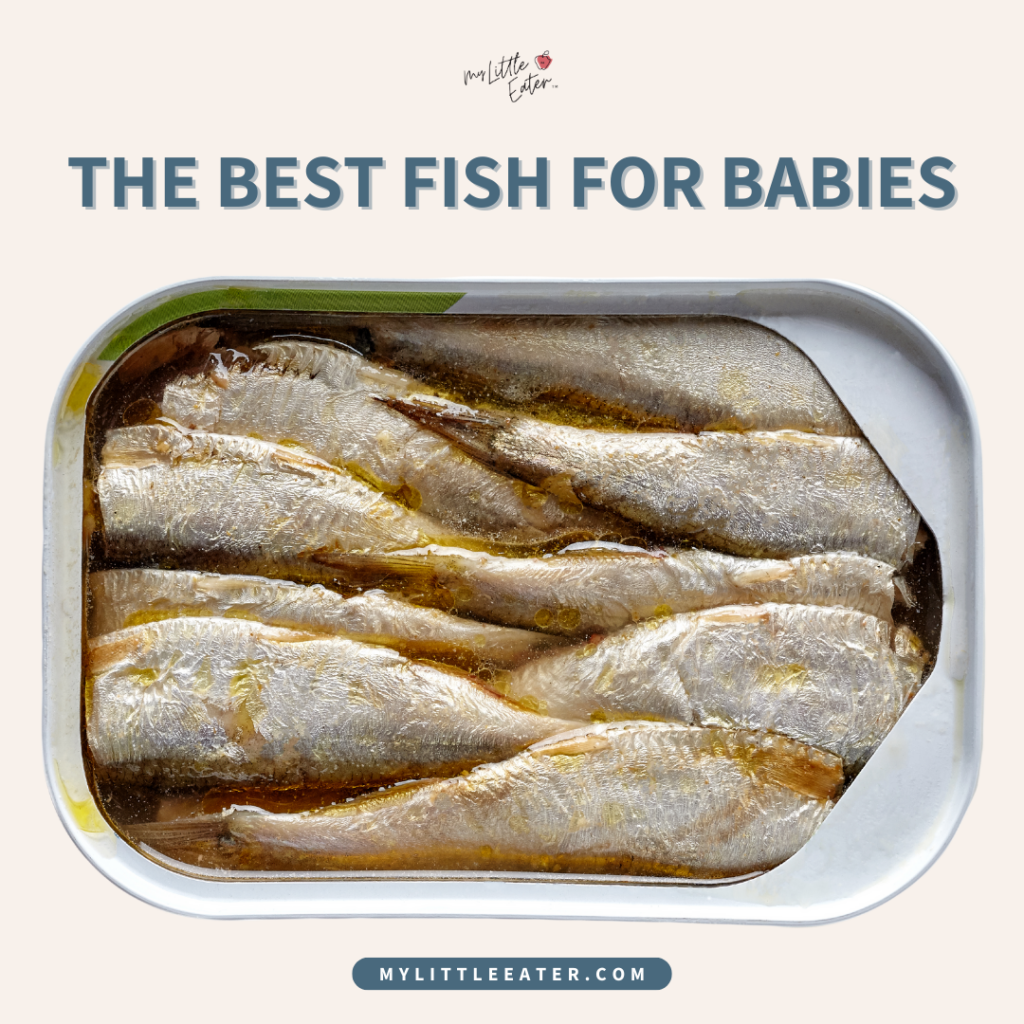









One Comment
My baby loved these! I was confused about how I was going to safely introduce shellfish to my baby, but these were perfect! Thanks!